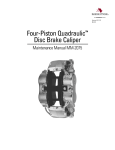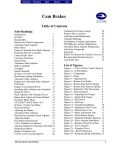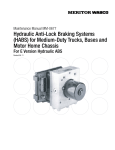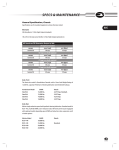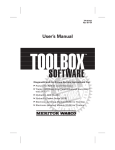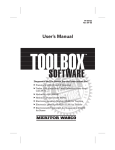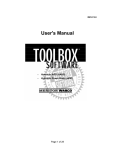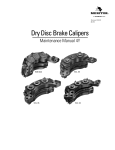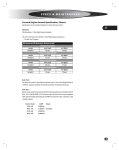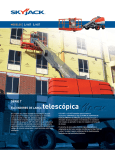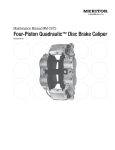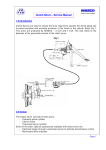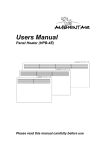Download TP-1039 - Meritor WABCO
Transcript
TP-1039 Issued 03-10 Technical Bulletin Hazard Alert Messages Read and observe all Warning and Caution hazard alert messages in this publication. They provide information that can help prevent serious personal injury, damage to components or both. WARNING To prevent serious eye injury, always wear safe eye protection when you perform vehicle maintenance or service. Failure to bleed the system whenever any hydraulic system fitting is loosened or disconnected will allow air to remain in the system. This will prevent the hydraulic pressure in the brake system from rising enough to apply the brakes correctly. This will cause the stopping distance to increase and can result in serious personal injury. Never reuse hydraulic brake fluid that has been removed from a vehicle. Hydraulic brake fluid that has been removed can be contaminated and can cause damage, loss of braking and serious personal injury. Always discard hyraulic brake fluid in accordance with applicable environmental requirements. Use only the type of hydraulic brake fluid specified by the equipment manufacturer. Do not use or mix different types of hydraulic brake fluid. The incorrect hydraulic brake fluid will damage the rubber parts of the brake caliper and can cause damage, loss of braking and serious personal injury. Do not let the brake master cylinder fluid get below the minimum level during the bleeding operation. Keep the master cylinder reservoir filled with new DOT-approved brake fluid, as specified by the original equipment manufacturer. Failure to keep the brake reservoir level above minimum could result in more air entering system, making it impossible to effectively bleed the system. Meritor WABCO Hydraulic Power Brake (HPB) System Bleeding Procedures Issued 1TP-1039 Technical 03-10 Bulletin CAUTION Hydraulic brake fluid is a caustic substance. Contact with hydraulic brake fluid can cause skin irritation. Do not let hydraulic brake fluid touch any painted surfaces, as it will remove the paint. Hydraulic brake fluid may also damage certain non-metal surfaces. Do not let fluid get on brake pads, shoes, rotors or disks. Observe the following when working on the braking system. CAUTION Prior to working on the braking system, all bleeder screws and the master cylinder cap must be cleaned thoroughly; cleanliness of fluid and areas around the service points have to be maintained. Do not use mineral oil-based fluid for this cleaning. Using mineral oil-based fluid can contaminate brake fluid and could damage the interior of the components and cause a system malfunction. Cover all electrical connectors near the bleeder screws carefully to make certain that no brake fluid enters the terminals or plugs. NOTE: After removing a component or disconnecting a brake tube connection, block off ports and brake tubes with appropriate plugs to prevent the ingress of dirt and unnecessary loss of fluid. Use only new specified brake fluid from a sealed container to refill the system. Refer to the specification on the Master Cylinder (MC) reservoir or in the vehicle service manual. If a lubricant is required to aid assembly, use only the specified brake fluid from a sealed container. Do not use any other assembly lubricant. During bleeding procedures, brake fluid level must not be allowed to fall below the MIN mark on the master cylinder reservoir. The master cylinder reservoir should be regularly checked and filled to the MAX mark. Perform the bleeding procedure exactly as described in the instructions. Perform the reservoir top-off procedure, when bleeding is complete. Refer to technical publication TP-09121, Filling the Hydraulic Power Brake (HPB) Master Cylinder Reservoir, for instructions on filling the master cylinder. After completing all desired brake service operations, test the braking system for function and check for leakage. Use DOT 3 or DOT 4 hydraulic brake fluid. Refer to the vehicle specification sheet to determine which fluid to use. How to Obtain Additional Maintenance and Service Information Refer to Maintenance Manual MM-0401, Meritor WABCO Hydraulic Power Brake (HPB) System; and technical publication TP-09121, Filling the Hydraulic Power Brake (HPB) Master Cylinder Reservoir. Call ArvinMeritor’s Customer Service Center at 800-535-5560 to obtain these publications. Meritor WABCO publications are also available on our website: While fully depressing the brake pedal, select the Deplete Accumulators function from the TOOLBOX™ Software EOL pull-down menu. The pedal must remain fully depressed during the entire process, until the TOOLBOX™ Software displays the completion message. Ensure that the pressure in both accumulators is reading zero on the diagnostic main screen then release the brake pedal. 6. Verify that the brake fluid level in the master cylinder reservoir is not below MAX level. NOTE: During bleeding procedures, brake fluid level must not be allowed to fall below the MIN mark on the master cylinder reservoir. The master cylinder reservoir should be regularly checked and filled to the MAX mark with new specified brake fluid from a sealed container. Brake Bleeding Procedures Prepare the pressure bleeder device according to the instructions provided with the equipment. NOTE: The pressurized fill and bleed equipment used can be either “air over fluid” or “fluid over air” type. 8. Install a suitable adapter from the fill and bleed equipment to the master cylinder reservoir filler neck. Verify that the adapter and bleed equipment are securely tightened onto the master cylinder reservoir filler neck. 9. Remove the rubber caps from the two relay valve bleeder screws located on the hydraulic control unit (HCU). Figure 1. The pressure-assisted brake bleeding procedures may be used with any fill and bleed equipment capable of filling the system and creating pressure in the master cylinder reservoir. Pressure Bleed Procedures B. Turn the ignition OFF. 7. Meritor WABCO does not approve using manual bleeding procedures. Fully depress the brake pedal a minimum of 30 times. The pressure in each brake circuit can be monitored using the TOOLBOX™ Software. Ensure that the pressure in each accumulator is at 0 psi. 5. www.meritorwabco.com The following brake bleeding methods explain how to bleed the hydraulic power brake system during installation, or in the event of air in the brake system. A. Figure 1 Master Cylinder Circuit 1. Park the vehicle on a level surface. Apply the parking brake and block the wheels to prevent the vehicle from moving. 2. Turn the ignition OFF and remove the two 30-amp Maxi fuses for the brake system motors. Refer to the vehicle manufacturer’s specifications to determine where the fuses are located. 3. Connect the diagnostic laptop to the diagnostic connector located in the cab, under the instrument panel. Set the ignition key to ON and open the TOOLBOX™ Software program. 4. Deplete pressure in the accumulators. There are two ways of depressurizing the system as follows. TP-1039 Issued 03-10 Page 2 1 1 2 3 4 2 3 4 4008096a BLEEDER PORT — PRIMARY MASTER CYLINDER CIRCUIT MASTER CYLINDER INPUT PORT — PRIMARY CIRCUIT MASTER CYLINDER INPUT PORT — SECONDARY CIRCUIT BLEEDER PORT — SECONDARY MASTER CYLINDER CIRCUIT Figure 1 Copyright ArvinMeritor, Inc., 2010 (16579/22882) Printed in USA 10. Fit the bleeder hose onto one relay valve bleeder screw located on the hydraulic compact unit. 11. Submerge the free end of the bleeder hose into the partially filled bleed bottle. Brake Caliper Circuit 1. Park the vehicle on a level surface. Apply the parking brake and block the wheels to prevent the vehicle from moving. 2. Turn the ignition OFF and remove the two 30-amp Maxi fuses for the brake system motors. Refer to the vehicle manufacturer’s specifications to determine where the fuses are located. 3. Connect the diagnostic laptop to the diagnostic connector located in the cab, under the instrument panel. Set the ignition key to ON and open the TOOLBOX™ Software program. 4. Deplete pressure in the accumulators. There are two ways of depressurizing the system as follows. 12. Apply 35 psi (2.4 bar) of pressure from the fill and bleed equipment to the master cylinder reservoir. 13. Open one of the relay valve bleeder screws until the fluid begins to flow (about 3/4 turn). Allow the fluid to run until 8.5 ounces (250 cc) has been collected. Take note of the fluid level in the bottle before starting. 14. When no further air bubbles enter the bleed bottle, close the bleeder screw. Remove the bleeder hose and tighten the bleeder screw to 35.4 to 39.8 lb-in (4 to 4.5 Nm). @ NOTE: Verify the fluid level in the master cylinder reservoir. During bleeding procedures, the brake fluid must not be allowed to fall below the MIN mark on the master cylinder reservoir. The master cylinder reservoir should be regularly checked and filled to the MAX mark. 15. Repeat Steps 13 and 14 with the second bleeder screw. 16. If brake caliper circuit bleeding is required, refer to the procedure in this section. 17. If brake caliper circuit bleeding is NOT required, install the two 30-amp pump motor fuses. 18. Turn the ignition ON. With 35 psi (2.4 bar) pressure applied to the master cylinder reservoir, the HCU pump motors will start up automatically and fill the accumulators. Approximate running time is 45 seconds. The brake light and buzzer will turn OFF. A. Fully depress the brake pedal a minimum of 30 times. The pressure in each brake circuit can be monitored using the TOOLBOX™ Software. Ensure that the pressure in each accumulator is at 0 psi. B. While fully depressing the brake pedal, select the Deplete Accumulators function from the TOOLBOX™ Software EOL pull-down menu. The pedal must remain fully depressed during the entire process, until the TOOLBOX™ Software displays the completion message. Ensure that the pressure in both accumulators is reading zero on the diagnostic main screen then release the brake pedal. 5. Turn the ignition OFF. 6. Verify that the brake fluid level in the master cylinder reservoir is not below MAX level. NOTE: During bleeding procedures, brake fluid level must not be allowed to fall below the MIN mark on the master cylinder reservoir. The master cylinder reservoir should be regularly checked and filled to the MAX mark with new specified brake fluid from a sealed container. 19. Release the pressure from the master cylinder reservoir. 20. Remove the bleed equipment. Fill or drain the master cylinder reservoir up to the MAX mark with new specified brake fluid from a sealed container. 21. Install the master cylinder reservoir cap. 7. Prepare the pressure bleeder device according to the instructions provided with the equipment. 22. Using the diagnostic laptop and the TOOLBOX™ Software program, clear all the inactive fault codes. NOTE: The pressurized fill and bleed equipment used can be either “air over fluid” or “fluid over air” type. 23. Turn the ignition OFF and disconnect the diagnostic laptop from the diagnostic connector. 8. 24. Check the system for external leaks. Install a suitable adapter from the fill and bleed equipment to the master cylinder reservoir filler neck. Verify that the adapter and bleed equipment are securely tightened onto the master cylinder reservoir filler neck. 25. Remove the wheel blocks. NOTE: If all wheel ends are to be bled, use the following bleeding order: right rear, left rear, right front, left front. 9. (16579/22882) Printed in USA Fit the bleeder hose onto the caliper bleeder screw at one wheel end. Copyright ArvinMeritor, Inc., 2010 TP-1039 Issued 03-10 Page 3 10. Submerge the free end of the bleeder hose into the bleed bottle. 11. Apply 35 psi (2.4 bar) of pressure from the fill and bleed equipment to the master cylinder reservoir. 12. Open one caliper bleeder screw until fluid begins to flow (3/4 turn). Allow the fluid to run until 8.5 ounces (250 cc) has been collected. Take note of the fluid level in the bottle before starting. Figure 2. Figure 2 15. If the vehicle is equipped with a power parking brake – SAHR canister, then bleed the SAHR circuit now using Steps 9-13 of the Spring-Applied/Hydraulic-Release (SAHR) Parking Brake Circuit pressure bleed procedure in this section. 16. Install the two 30-amp pump motor fuses. 17. Turn the ignition ON. With 35 psi (2.4 bar) of pressure applied to the master cylinder reservoir, the HCU pump motors will start up automatically and fill the accumulators. Approximate running time is 45 seconds. The brake light and buzzer will turn OFF. 18. Release the pressure from the master cylinder reservoir. 19. Remove the bleed equipment. Fill or drain the master cylinder reservoir up to the MAX mark with new specified brake fluid from a sealed container. 20. Install the master cylinder reservoir cap. 21. Using the diagnostic laptop and the TOOLBOX™ program, while fully holding the brake pedal depressed, select the Deplete Accumulators function from the TOOLBOX™ Software EOL pull-down menu. The pedal must remain fully depressed during the entire process, until the TOOLBOX™ Software displays the dialog box that will indicate the completion of the function. Ensure that the pressure in both accumulators is reading zero on the diagnostic main screen, then release the brake pedal. 1004710a NOTE: The DEPLETE ACCUMULATORS function performs a cycle of releasing the pressure and charging the pressure back up in each brake circuit. This cycle helps clear air from the HCU into the reservoir. Figure 2 13. If no further air bubbles enter the bleed bottle, close the bleeder screw. Remove the bleeder hose and tighten the bleeder screw. Refer to the vehicle manufacturer’s torque specification for the caliper bleeder screws. For Bosch Pin Slider calipers, tighten the screws to 106-142 lb-in (12-16 Nm). For Meritor Quadraulic™ disc brake calipers, tighten the screws to 133 lb-in (15 Nm). NOTE: Refer to the vehicle manufacturer’s specifications for specific information about bleeding the calipers. Some calipers have multiple bleeder screws and require removal of the wheels and tires to access the bleeder screws. Each bleeder screw must be bled. NOTE: Verify the fluid level in the master cylinder reservoir. During bleeding procedures, the brake fluid must not be allowed to fall below the MIN mark on the master cylinder reservoir. The master cylinder reservoir should be regularly checked and filled to the MAX mark. 14. Repeat Steps 9-13 with the other calipers in the specified order. TP-1039 Issued 03-10 Page 4 22. Repeat Step 21 two times. 23. Using the diagnostic laptop and the TOOLBOX™ Software program, clear all the inactive fault codes. 24. Turn ignition OFF and disconnect the diagnostic laptop from the diagnostic connector. 25. Check the system for external leaks. 26. Remove wheel blocks. Spring-Applied/Hydraulic Release (SAHR) Parking Brake Circuit Before bleeding the circuit, you must disconnect the parking brake cable from the spring-applied/hydraulic release (SAHR) canister. This is to ensure that the SAHR piston achieves the full stroke and forces most of the fluid volume out of the SAHR canister, thus moving potential entrapped air into the bleeder screw area. 1. Park the vehicle on a level surface. Apply the parking brake and block the wheels to prevent the vehicle from moving. Copyright ArvinMeritor, Inc., 2010 (16579/22882) Printed in USA 2. Turn the ignition OFF and remove the two 30-amp Maxi fuses for the brake system motors. Refer to the vehicle manufacturer’s specifications to determine where the fuses are located. 12. Open the SAHR bleeder screw until fluid begins to flow (3/4 turn). Allow the fluid to run until 8.5 ounces (250 cc) has been collected. Take note of the fluid level in the bottle before starting. 3. Connect the diagnostic laptop to the diagnostic connector located in the cab, under the instrument panel. Set the ignition key to ON and open the TOOLBOX™ Software program. 4. Deplete pressure in the accumulators. There are two ways of depressurizing the system as follows. 13. If no further air bubbles enter the bleed bottle, close the bleeder screw. Remove the bleeder hose and tighten the bleeder screw to specified torque. Refer to the vehicle manufacturer’s specifications for the correct torque value. A. Fully depress the brake pedal a minimum of 30 times. The pressure in each brake circuit can be monitored using the TOOLBOX™ Software. Ensure that the pressure in each accumulator is at 0 psi. B. While fully depressing the brake pedal, select the Deplete Accumulators function from the TOOLBOX™ Software EOL pull-down menu. The pedal must remain fully depressed during the entire process, until the TOOLBOX™ Software displays the completion message. Ensure that the pressure in both accumulators is reading zero on the diagnostic main screen then release the brake pedal. 14. Install the two 30-amp pump motor fuses. 15. Turn the ignition ON. The HCU pump motors will start up automatically and fill the accumulators. Approximate running time is 45 seconds. The brake light and buzzer will turn OFF. 16. Release the pressure from the master cylinder reservoir. 17. Remove the bleed equipment. Fill or drain the master cylinder reservoir up to the MAX mark with new specified brake fluid from a sealed container. 18. Install the master cylinder reservoir cap. 5. Turn the ignition OFF. 19. Connect the parking brake cable to the SAHR canister. Refer to the vehicle manufacturer’s instructions for how to connect and correctly adjust the parking brake cable. Verify correct application and release at the parking brake. 6. Verify that the brake fluid level in the master cylinder reservoir is not below MAX level. 20. Using the diagnostic laptop and the TOOLBOX™ Software program, clear all the inactive fault codes. NOTE: During bleeding procedures, brake fluid level must not be allowed to fall below the MIN mark on the master cylinder reservoir. The master cylinder reservoir should be regularly checked and filled to the MAX mark with new specified brake fluid from a sealed container. 21. Turn ignition OFF and disconnect the diagnostic laptop from the diagnostic connector. Prepare the pressure bleeder device according to the instructions provided with the equipment. Changing Hydraulic Brake Fluid 7. NOTE: The pressurized fill and bleed equipment used can be either “air over fluid” or “fluid over air” type. 8. Install a suitable adapter from the fill and bleed equipment to the master cylinder reservoir filler neck. Verify that the adapter and bleed equipment are securely tightened onto the master cylinder reservoir filler neck. 9. Fit the bleeder hose onto the bleeder screw on the SAHR chamber. 10. Submerge the free end of the bleeder hose into the bleed bottle. 11. Apply 35 psi (2.4 bar) of pressure from the fill and bleed equipment to the master cylinder. (16579/22882) Printed in USA 22. Check the system for external leaks. 23. Remove wheel blocks. 1. Park the vehicle on a level surface. Apply the parking brake and block the wheels to prevent the vehicle from moving. 2. Turn the ignition OFF and remove the two 30-amp Maxi fuses for the brake system motors. Refer to the vehicle manufacturer’s specifications to determine where the fuses are located. 3. Connect the diagnostic laptop to the diagnostic connector located in the cab, under the instrument panel. Set the ignition key to ON and open the TOOLBOX™ Software program. 4. Deplete pressure in the accumulators. There are two ways of depressurizing the system as follows. A. Fully depress the brake pedal a minimum of 30 times. The pressure in each brake circuit can be monitored using the TOOLBOX™ Software. Ensure that the pressure in each accumulator is at 0 psi. Copyright ArvinMeritor, Inc., 2010 TP-1039 Issued 03-10 Page 5 B. While fully depressing the brake pedal, select the Deplete Accumulators function from the TOOLBOX™ Software EOL pull-down menu. The pedal must remain fully depressed during the entire process, until the TOOLBOX™ Software displays the completion message. Ensure that the pressure in both accumulators is reading zero on the diagnostic main screen then release the brake pedal. 16. Fill the master cylinder reservoir up to the MAX mark with new specified brake fluid from a sealed container. Use DOT 3 or DOT 4 hydraulic brake fluid. Refer to the vehicle manufacturer’s specifications to determine which fluid to use. NOTE: You can speed up the filling process by opening the bleeder screw of one of the rear calipers. This will allow better brake fluid flow into the system by expelling the air through the bleeder screw. Close the bleeder screw when no further air is exiting the bleeder screw. 5. Turn the ignition OFF. 6. Prepare the pressure bleeder device according to the instructions provided with the equipment. 17. Bleed the master cylinder circuit using the master cylinder bleeding procedure in this section. NOTE: The pressurized bleed equipment used for this drain procedure must be the “air over hydraulic” type. 18. Bleed the rest of the brake system using the brake caliper circuit bleeding procedure in this section. 7. Install a suitable adapter from the fill and bleed equipment to the master cylinder reservoir filler neck. Verify that the adapter and bleed equipment are securely tightened onto the master cylinder reservoir filler neck. 8. Apply 35 psi (2.4 bar) of pressure from the fill and bleed equipment to the master cylinder. 9. Fit the bleeder hose onto the caliper bleeder screw at one wheel end. 10. Submerge the free end of the bleeder hose into the bleed bottle. 11. Open the bleeder screw until fluid begins to flow (3/4 turn). Allow the fluid to run until the circuit is completely drained and no more fluid comes out. 12. Close the bleeder screw. 13. Repeat Steps 8-12 for: A. the remaining calipers, B. the two relay bleeder screws, and C. the SAHR bleeder screw, if equipped 14. Release the pressure from the master cylinder reservoir. 15. Remove the bleed equipment. Meritor WABCO Vehicle Control Systems 2135 West Maple Road Troy, MI 48084-7121 USA 800-535-5560 meritorwabco.com Information contained in this publication was in effect at the time the publication was approved for printing and is subject to change without notice or liability. Meritor WABCO reserves the right to revise the information presented or to discontinue the production of parts described at any time. Copyright 2010 ArvinMeritor, Inc. All Rights Reserved Printed in USA TP-1039 Issued 03-10 (16579/22882)






